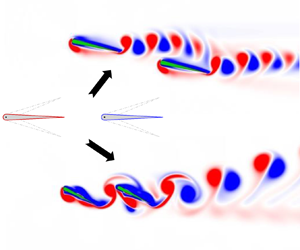Article contents
Two-dimensional hydrodynamic schooling of two flapping swimmers initially in tandem formation
Published online by Cambridge University Press: 27 April 2022
Abstract

The effect of hydrodynamic interactions on the collective locomotion of fish schools is still poorly understood. In this paper, the flow-mediated organization of two tandem flapping foils, which are free in both the longitudinal and lateral directions, is numerically studied. It is found that the tandem formation is unstable for two foils when they can self-propel in both the longitudinal and lateral directions. Three types of resultant regular formations are observed, i.e. semi-tandem formation, staggered formation and transitional formation. Which type of regular formation occurs depends on the flapping parameters and the initial longitudinal distance between the two foils. Moreover, there is a threshold value of the cycle-averaged longitudinal distance (which is approximately 0.55) below which both velocity enhancement and efficiency augmentation can be achieved by two foils in regular formations. The results obtained here may shed some light on understanding the emergence of regular formations of fish schools.
JFM classification
- Type
- JFM Papers
- Information
- Copyright
- © The Author(s), 2022. Published by Cambridge University Press
References
- 6
- Cited by





